When reading this writeup I recommend listening to the artist while you do it. It’ll help give context to all the decisions we made while putting the show together and hopefully you’ll be able to hear where we are going to use certain pieces of gear!
AWIP Level 1 Artist
Foreword
Modern Tales is a weird one for me. It’s almost a show I’ve been working on with a friend for years that only just came in to fruition. Franz from Modern Tales and I used to share a studio in London when he lived here years ago. He was ghost producing and working on his artist project which, at the time, we talked about taking live. It was getting good plays and some good hype but there was never quite a moment where it made sense to take the plunge. Building your first show is an expensive and time consuming endeavour. Don’t get me wrong, when it comes together it’s fucking magical. There’s a high you’ll get from playing to 5000 people for the first time that you won’t get anywhere else. It’s a Dragon you’ll chase the rest of your career. But in that experience you can provide something for your fan base unlike most other offerings your brand has. An experience where everybody is together in one moment sharing your music, moving to the same rhythm at the same time. It’s a unique interpretation of how that sound exists in physical space and the only rule is ‘Make the show as good as it can be’.
When Franz and his brother Jonas started working seriously on some music together over the pandemic Modern Tales was born. A marriage of Jonas’ house and techno roots and Franz’s falsetto top lines. It’s a culmination of 2 incredibly accomplished musicians reconnecting with their family to create something very different in the electronic space. Sending the music to some contacts and friends eventually landed it in the lap to Rufus Du Sol who, fortunately, loved it and connected with their vision immediately. Quickly, Modern Tales were offered a deal with Rose Avenue records as well as a support slot on the upcoming Rufus Du Sol tour to help launch the project. Franz and Jonas wanted to do it live. It was finally time to build the show we talked about building in a wanky hipster cafe in North London years ago.
Artist Brief
Modern Tales needed to approach the support tour with something that would stand apart from other live electronic shows but also get on stage and off within the constraints of being a support act. Franz will be singing live and covering all the top lines but also wants to be able to augment his vocal with ‘how the fuck did he do that?’ moments. He and Jonas both come from Producer backgrounds and this needs to be reflected in their setup and performance. Despite their competency as players, forcing them in to intense playing roles would be naive and not get the results we’re after. There are 2 very important things here.
- Is Franz nailing the vocals and doing something most people aren’t?
- Is Jonas building interesting reinterpretations of the records as if he was in his studio?
Achieving that is what will make this show stand out and help drive it to the next level.
Oh, and we also have to be able to tour it with the following team…
- Franz (Artist)
- Jonas (Artist)
- Tom (AWIP MD)
Let’s fucking go.
Performance Environment and Tech
Artist POV:
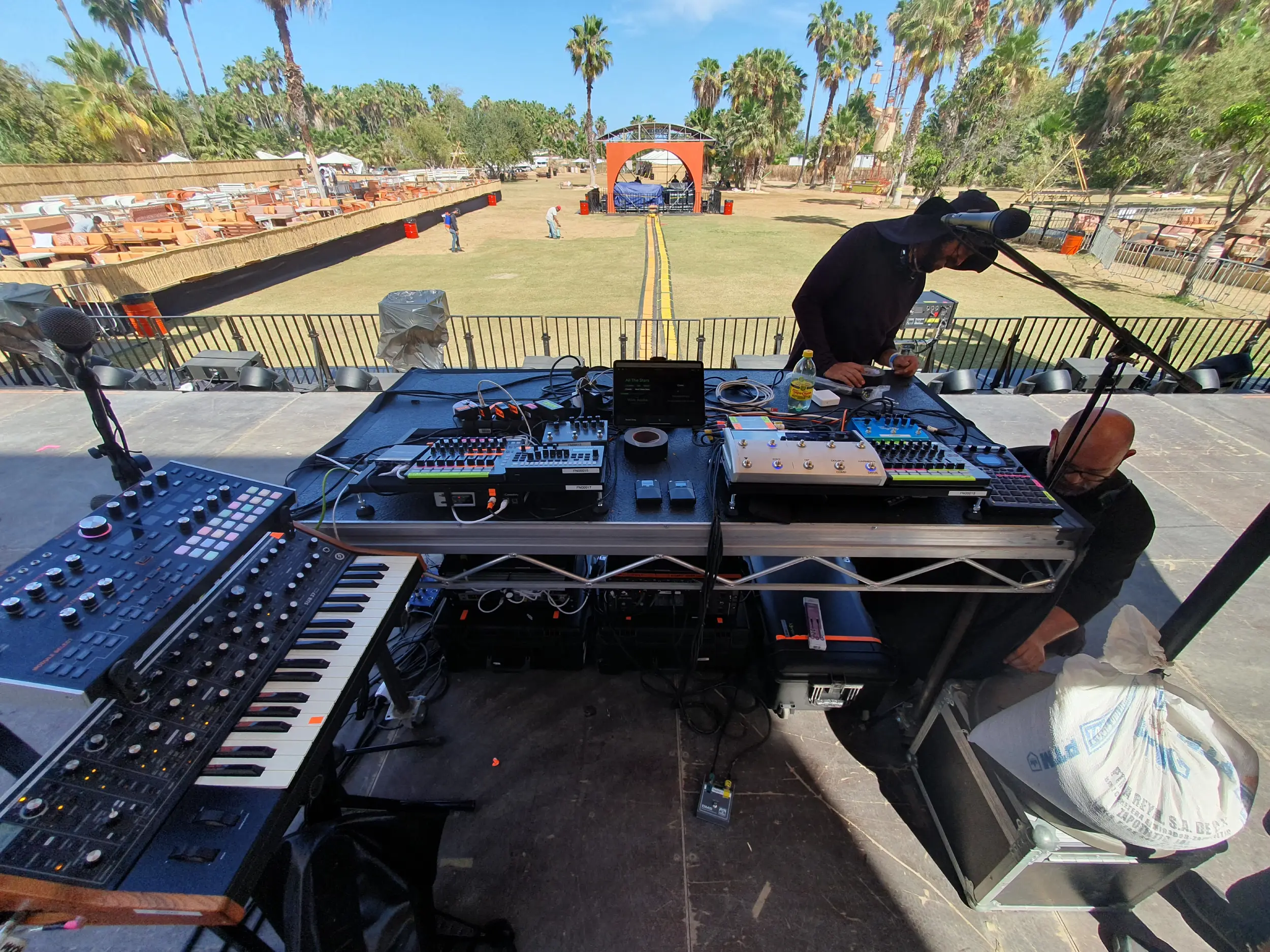
There’s 2 worlds here. Franz World and Jonas World. Each lean in to different parts of the gig covered by the boys. Franz is vocal/sampler driven and Jonas is synth/FX driven. Despite their differences each is incredibly important to a good show and the performance can’t function without it.
As with any live electronic show you can’t start to understand how it has been deployed without seeing a list of gear. There’s a bit of a journey with Franz’s vocal chain that we’ll walk through later so I’m just going to list everything we have ever used here and we can get in to what stayed and got cut later.
Franz World
- TC Helicon Voicelive 3
- Roland VE-500
- Roland SP-404 Mk2
- Plamer MS02
- Pamer DMS
- Novation Launchcontrol XL
- Sennheirser e945
- Pioneer RMX1000
- Strymon Big Sky
- Palmer PedalBay60L
Jonas World
- TR-6S
- Moog Sub37
- Ashun Sound Machines Hydrasynth
- Novation Launchcontrol XL
- Strymon Timeline
- Palmer PedalBay60L
Soundcards, MIDI and Networking
- iConnectivity PlayAUDIO12
- iConnectivity MioXM
- Network Switches
- Belkin USB-C Power/Network Dongle
Software, Transport Control and Autocue
- Ableton Live 11 Suite
- Albeset 2.0
Computers
- Apple Macbook Pro 14inch M1 Pro
- 16GB Ram
- 1TB SSD
- Apple iPad Pro
Audio
- Behringer X32 Rack
- Palmer Pan16
- Presonus HP2
Stop Underestimating the Ability of In-House Engineers
Of course bringing your own FOH engineer will ensure your show sounds consistent. They can provide another pair of hands, more baggage allowance for fly pack, a reliable opinion on where your source needs work. There’s lots of reasons this position will help elevate your show but not all artists can afford this. Arguably, like any mix engineer, they’re only as good as the source you provide them and if you focus your effort on this source you’ll get the best out of this member of the team. For this reason I’d argue you can get incredibly far with the underrated talent when you arrive. These people are also likely to be the person who set up the PA. Run the PA every day. Have mixed a million bands on it. Make your source and channel list clear, have a conversation with these people and there’s no reason why you can’t have a great sounding show.
There will always be exceptions to this rule. Across any 3rd party you involve in your show there can be exceptions. You can pay top wages for a supposedly fantastic member of your team and it can still go terribly and not be at all what you expected. Ultimately you are responsible for your output so make sure you arm everybody around you with all the resources they need to make your show the best it can be.
On Modern Tales we used the following methodology to deploy the outputs from the X32.
Out 1-2: Drum Bus
Out 3-4: Music Bus
Out 5-6: Track BV
Out 7-8: Franz FX Bus(We’ll explain this properly later when we get in to Franz’s vocal chain)
We then have a run of simple mic outputs.
Franz Dry Vocal
Franz Wet Vocal
Jonas BV Vocal
Why Bus when you can Multitrack? Let’s talk gain structure
If you run the Drums, Music and BV bus at unity with each other you have a starting point for the mix. This sets the level of where everything else sits. If you need to do a small amount of EQ and dynamics to tune to the room you can but also you should be able to set all 3 of these buses to the same gain and have what we intend the studio mix to be. After this it should be obvious where to place Franz FX and all the vocal channels against these core 3 buses.
Drum Bus
A sum of the TR-6S drum machine and extra drums on track. As we always have the same mixer and drum machine these gains rarely change unless we don’t turn up the drum machine to our agreed unity. This means everything Jonas is doing with this instrument live is always at our intended level.
Music Bus
This is a sum of all the track bass, FX, soft samplers and track music as well as the Moog, Hydrasynth and Timeline. You basically get all of the core melodic but not vocal information here. Again, all the patches on the synths have been levelled per-patch to be the correct mix with the tracks coming from Ableton.
BV Bus
This is actually only the BVs coming from Ableton. Separating these is purely so FOH can get a good mix of vocals in the room. Any show with a lead vocalist should look to do this so the vocals are always right.
As much as we’ve been summing to buses here, this methodology scales to any size show. Consistent gains enable your engineers to mix consistently brilliant shows. The more they change regularly, especially when you hit 24+ channels, the more this person will be diving down the other end of a mixing console to turn down the your guitar solo that has a patch that’s disproportionally louder than the rest of the song. Yes, some things should be louder but within reason. Just because it’s great on your own in headphones doesn’t mean it’s great in a specific venue with a specific PA with the rest of the band.
Jonas’s Moog does it all
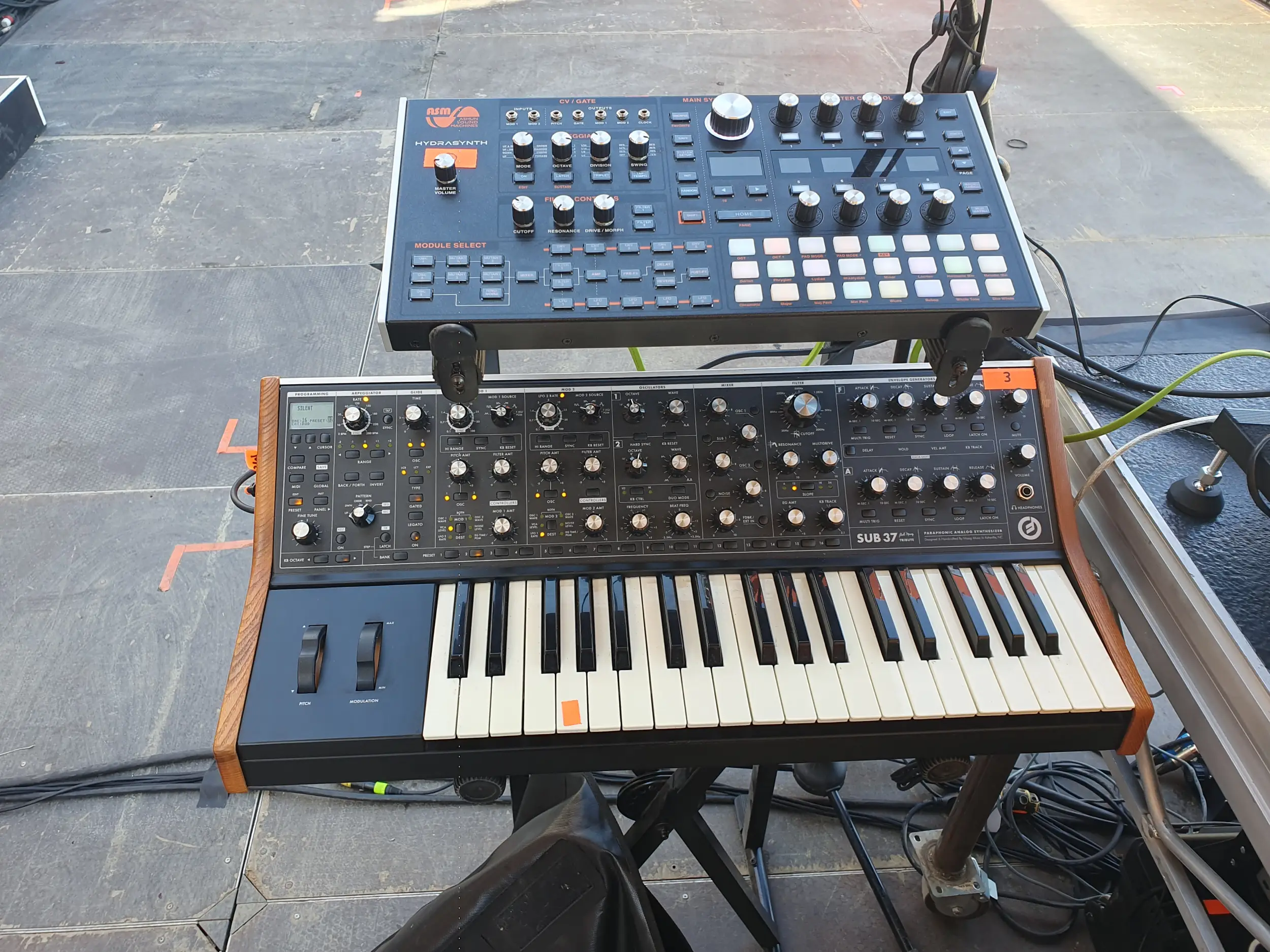
As well as using the fantastic synth engine the Sub37 also has Class Compliant USB MIDI. This is great as it means we can plug it in to the stage MioXM and use it to control software samplers as well as playing the Hydrasynth. Touring-wise this is a great way of getting 1 keyboard doing multiple functions to justify it going out on the show. It also reduces waste on the stage so Jonas as a performer is always interacting with his space as opposed to getting lost in multiple boxes that have 25% of a job.
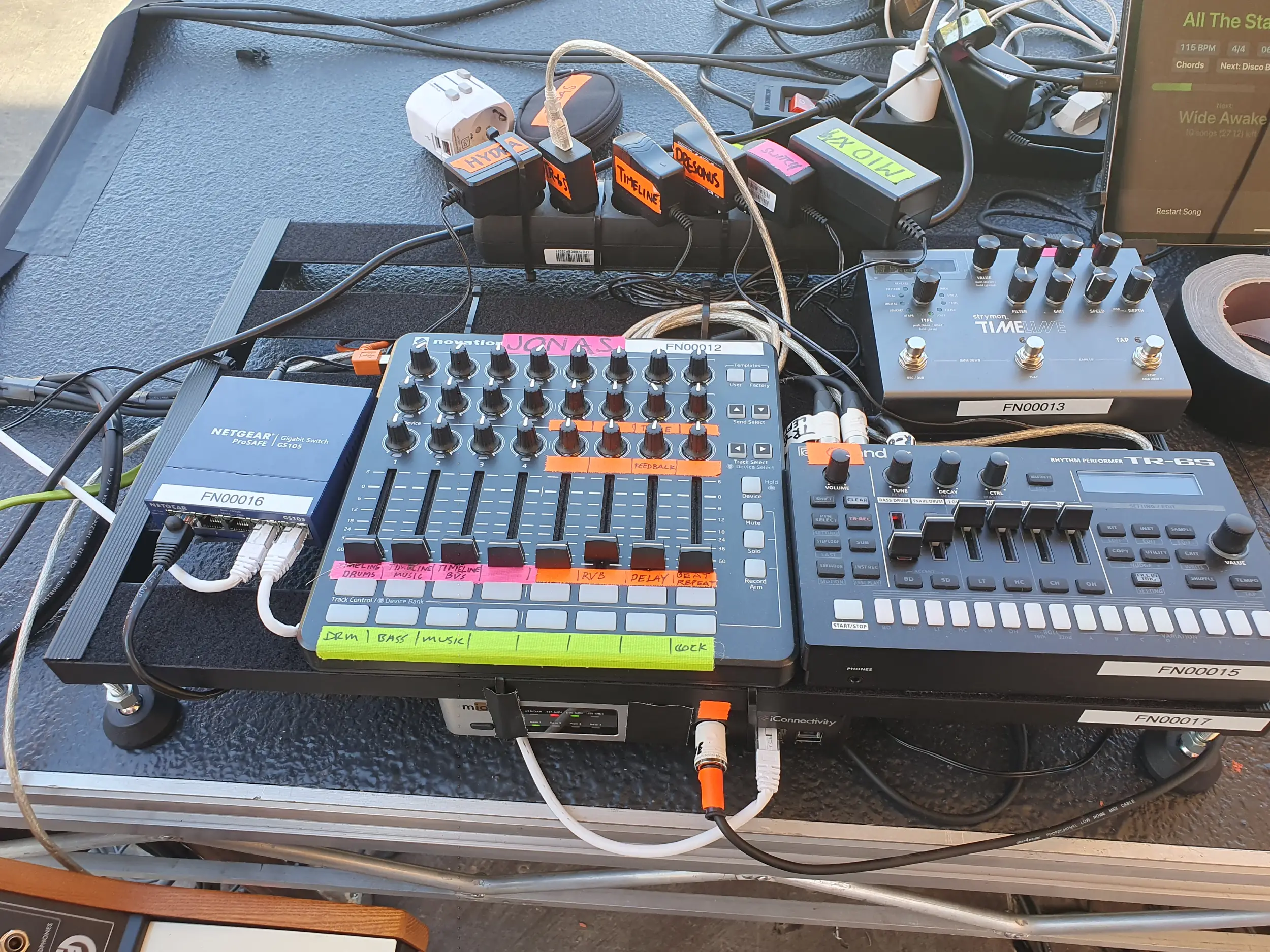
This keyboard gets a huge amount of use for these reasons. From doing the bass on Monster to playing a bunch of piano samplers we made it’s a go to for his world. Anything that’s played here can also be sent to the Timeline via the X32. He can choose what’s going to this send/return bus using his Launchcontrol XL. The routing to underpin this functionality looks something like this…
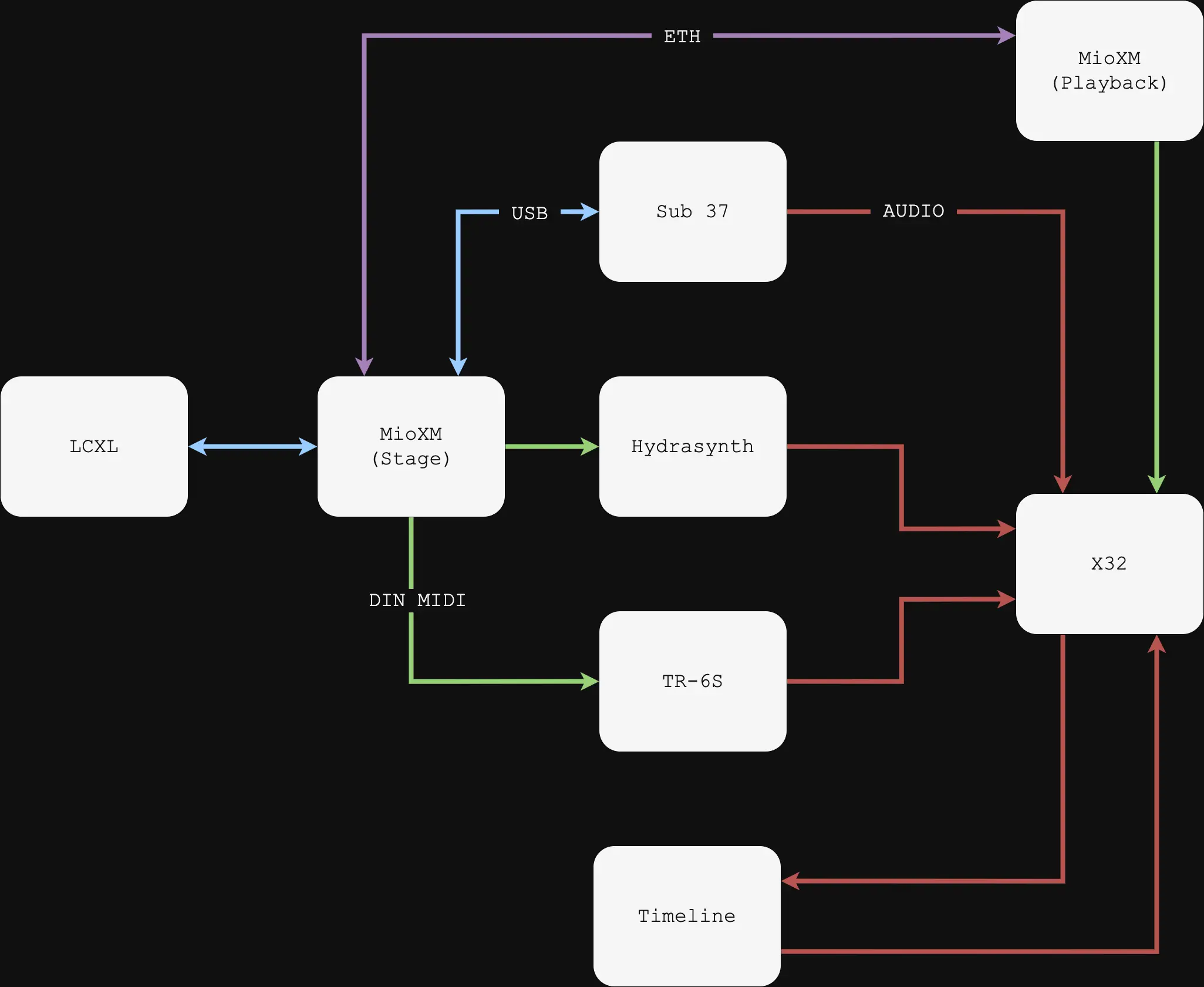
From here Jonas can also control a series of pre-defined Ableton FX on certain parts of the track which can then also be sent via the hardware FX loop. This creates some pretty crazy sound design opportunities mid-show.
Franz’s Vocal Chain of Doom
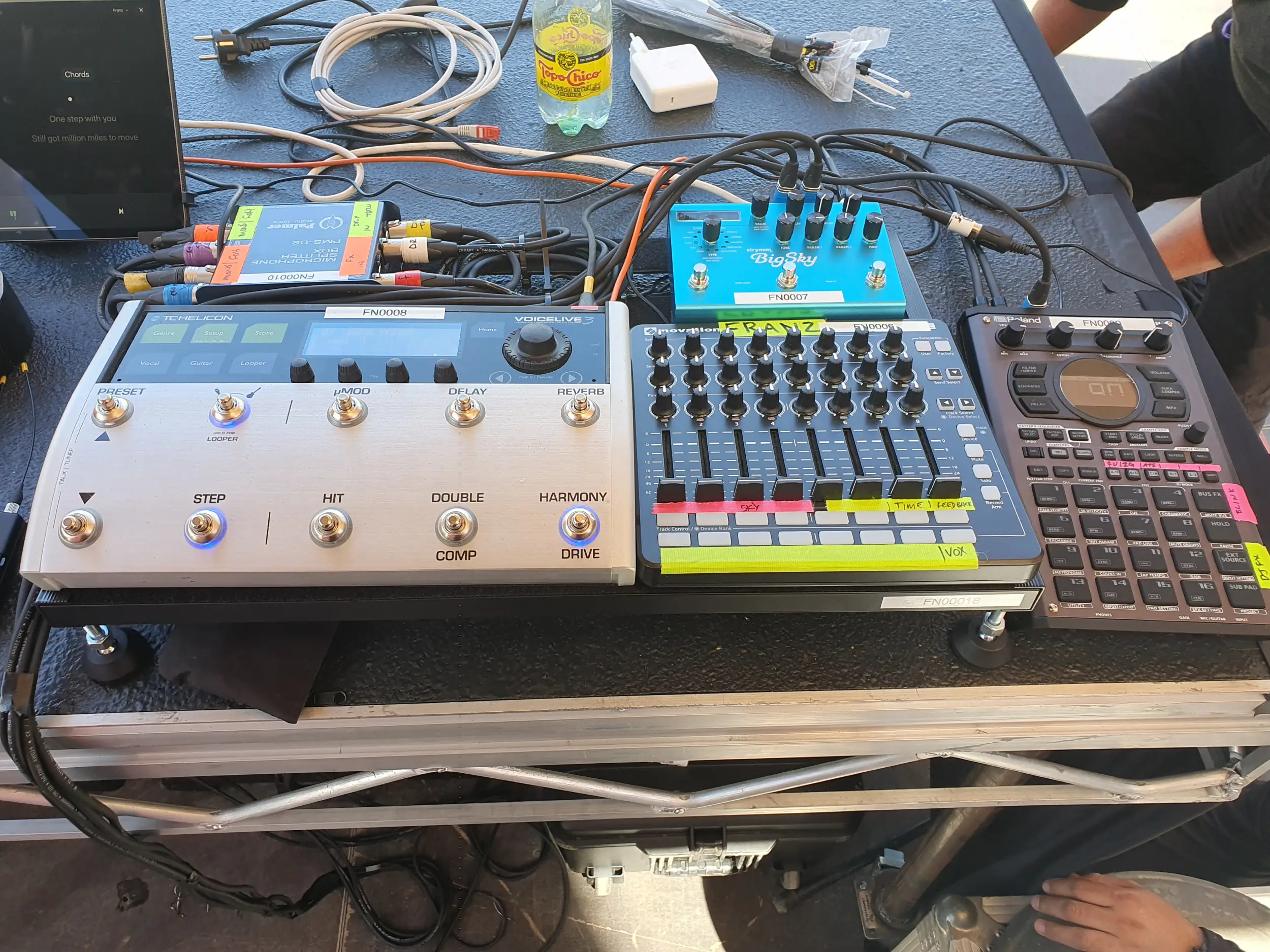
At the time of writing I’d say we’re at version 5 of Franz’s vocal chain. We’ve had lots of challenges with it to not only get it on stage in time but to preserve some unique and creative performance techniques he developed using the RMX1000. The chain used to look something like this…
Mic -> VE-500 -> Voicelive3 -> RMX1000 -> DI -> X32
--FX Loop--
Vox Chain -> X32 -[SEND]-> Big Sky -[RETURN]-> X32 -> FOHSome readers may be looking at this and thinking “What the fuck is wrong with you running the lead vocal down hi-gain outputs?”. And yes. You’d be correct. We should have found a better solution from the off.
The problem here is the way the RMX1000 is used.
Franz began sending small amounts of vocal in to the Roll function on the RMX. This meant he could do things like whistle in to it an create risers or catch the end of a phrase he was singing and loop it on the fly. This is great performance. It’s nothing we intended to achieve but it is something that we need to preserve now it happens. For 1 tour this was a trade-off but moving forward we had to have a better solution.
A quick interlude
I also want to quickly talk about an unexpected user experience with the Big Sky FX loop before we get in to how to deal with the live vocal glitch fx. I initially pitched the design to have a fader on Franz’s Launchcontrol so he could send small amounts of vocal in to the reverb pedal for some crazy washed out bits. The reality of this was that he just set himself a comfortable reverb mix for his ears that he wanted at FOH and left it. This was not what I expected the user to do even after explaining what would be the best course of action. Whatever your intended functionality it’s important to remember that none of it matters if the artist doesn’t intuitively understand it. If a system encourages a bad habit that is problematic then you need to redesign the system. Their experience in their performance environment has to be flawless every time in facilitating what they do both technically and creatively. Always step back, look at how someone performs a part, listen to how they perform a part and consider if you’ve made the right decision.
Back to the “how the fuck can Franz make crazy risers with his vocal as well as singing via mic gain outputs”.
Well. Here’s the current routing.
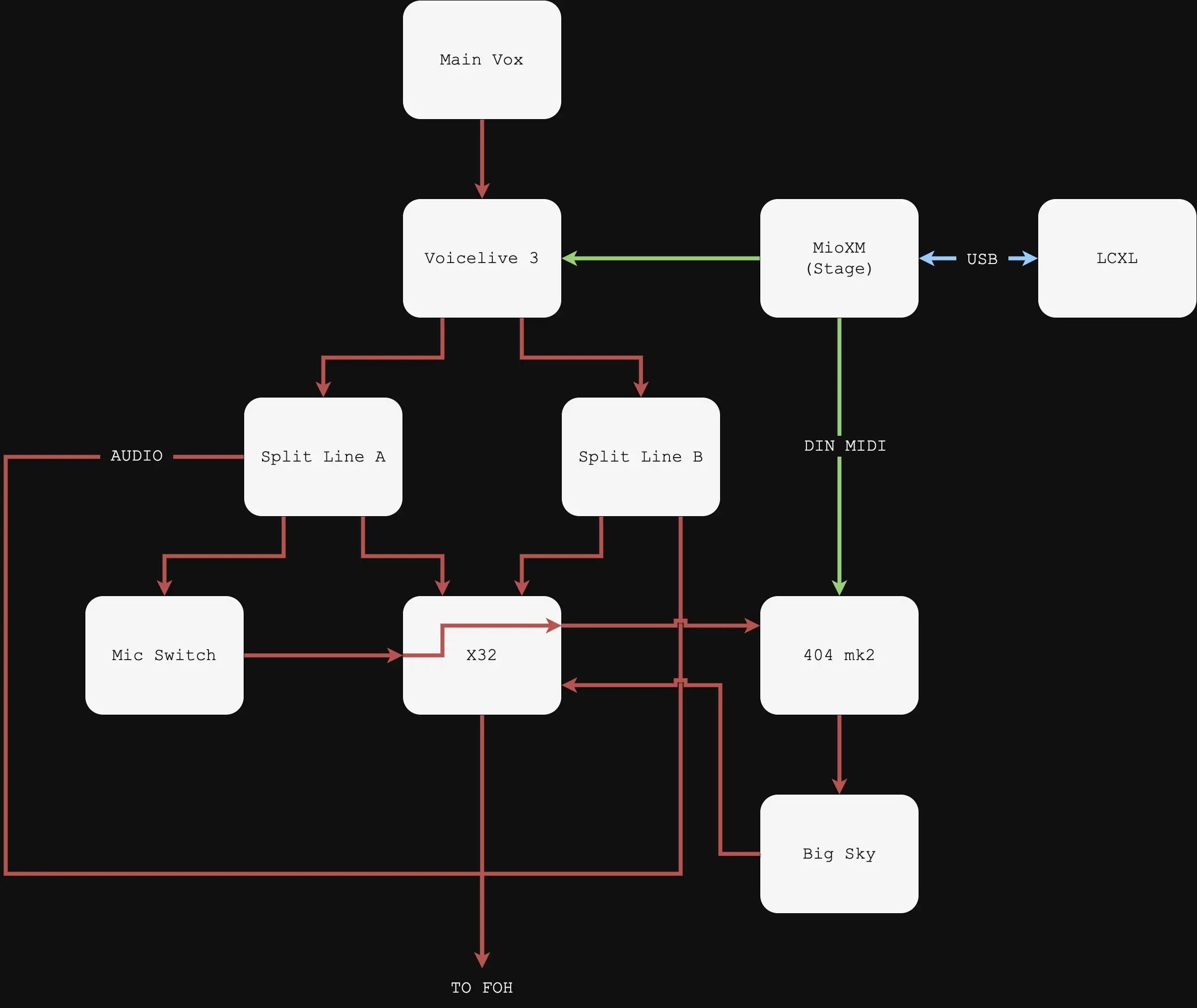
There’s always a trade off to achieve your goal
We had to drop a lot of stuff to get it right. We toyed with tuning systems but none of the hardware solutions could get the scales right, UAD was out of budget and, to be honest, Franz sings great already. There’s no creative uses of heavy autotune on the records so if we can get away without using it then, at this level, let’s get away with it.
When boiling down what’s really important and making gear decisions this is what we came to…
- Clean Lead Vocal
- Doubler/Harmony Engine Vocal
- Mad glitch/roll FX
Fortunately the Voicelive 3 does those first 2 points really well. It can run your clean and FX separately on the 2 outputs too. That’s pretty handy as it now means we can have 1 clean line and 1 totally FX driven line. In the various FX settings on this unit we can also turn down the lead level on the FX line. This means we now have purely vocal FX here when we want it. The Harmony engine will also happily react to MIDI we send it as well as only turning on when it sees this MIDI. We then refined all this in to a single patch on the Voicelive so Franz can turn his doubler on and off as he pleases and when we need some harmonies we just need some MIDI in Ableton. Simple.
The next issue is being able to fuck up Franz’s vocal live like he did with the RMX1000. How do we get this without a hi-gain output?
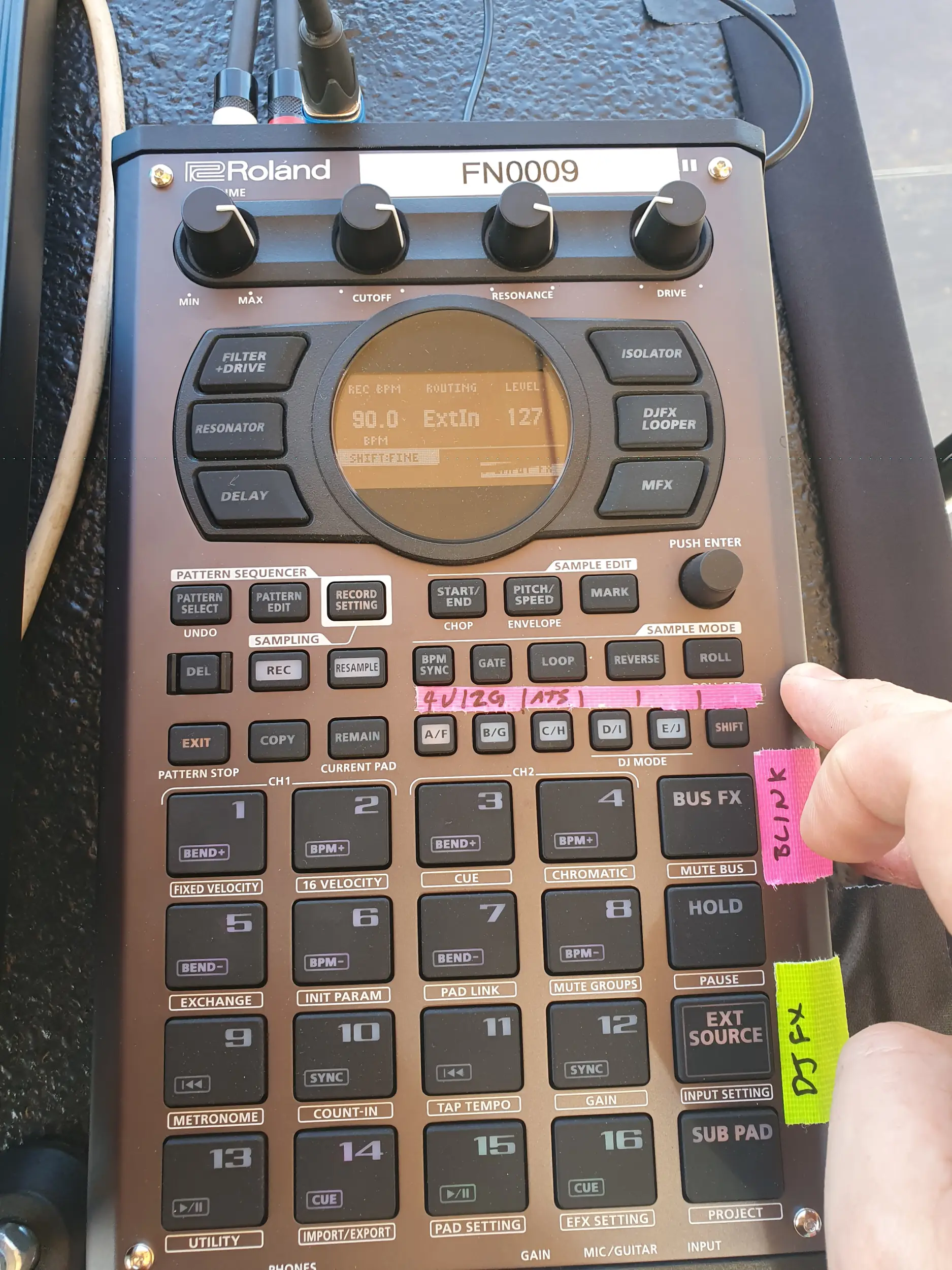
We recently got our hands on a SP-404 mk2 to play around. It has some crazy FX in it which you can do some mad sound design with. You can send audio via the audio input, customise all the main FX for this input and use them in real time. This unit also has all the sampler functionality you expect from a 404 as well as MIDI out. This means that in 1 fail swoop we expand Franz’s world to add both a live FX loop and something to play parts with when he isn’t singing. On a streamlined rig like this it’s almost a silver bullet.
We need to be able to cut that high gain loop though. As a main source of the feedback this is where our mic switch comes in. It’s almost like a manual gate that Franz can choose to send audio through. This means the 404 only ever gets as much as it needs and if there’s a problem we can literally sever the feedback loop instantly. This is a very different user experience but is a reasonable trade off for the functionality we are looking for.
Ableset 2.0 is fucking awesome
Honestly. Leo behind Ableset is doing some amazing things. I’ll elaborate fully in a dedicated Ableset blog about deploying it but here’s how it looks on Modern Tales…
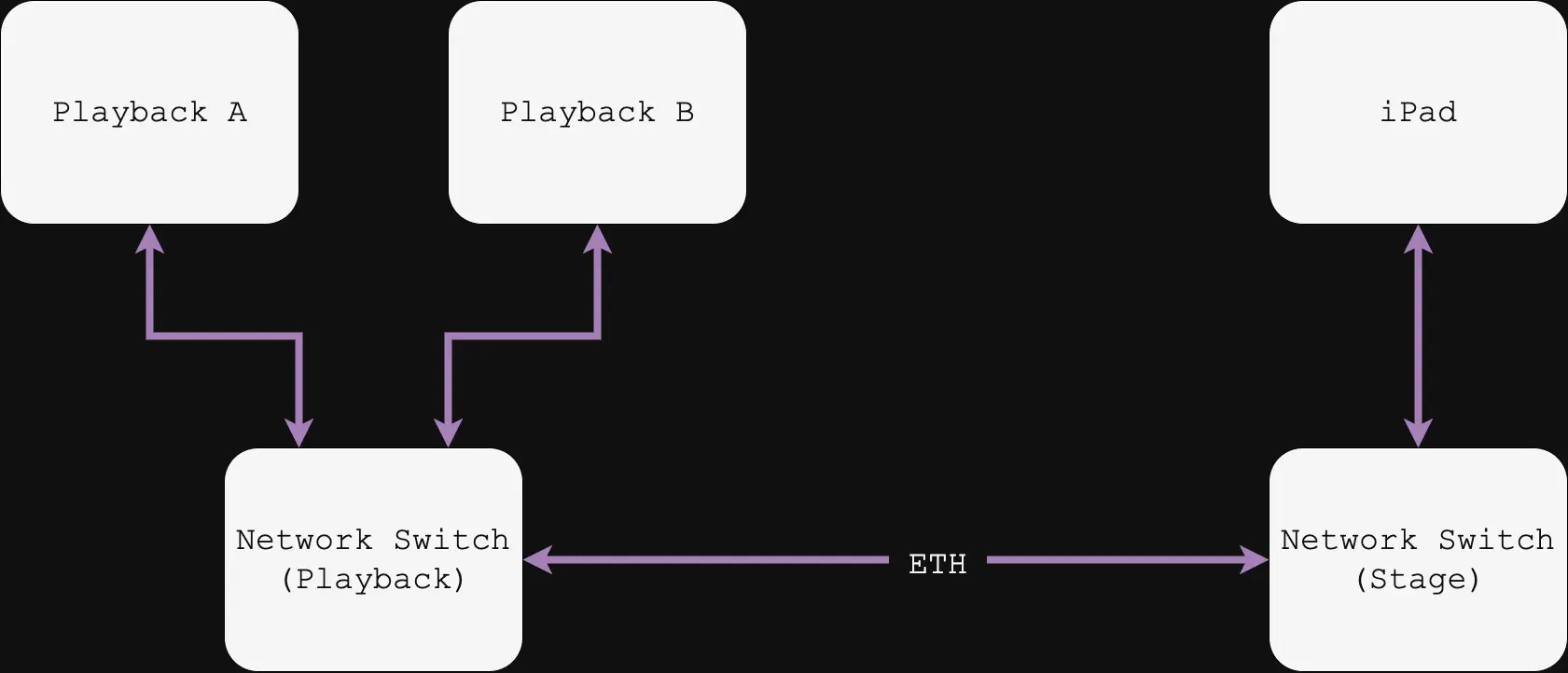
This was mostly so the boys could easily rehearse different tracks rather than play them separately on the show. As with a lot of electronic shows we have lots of pre-planned transitions to get from 1 track to another. On this show, however, the real game changer is Ableset’s Lyrics function. As well as using cues on the click track to remind the band what’s coming up and tones to tune to we can now also add small text notes to the tablet. This helps with many things such as reminding Franz of the first word of a song to reminding Jonas of a first chord.
These things may seem like cheating to some people but the reality of getting on a stage and playing a large scale, complex show is pretty daunting. You’d have to rehearse for months for it to be ready completely from memory and it’s likely you’d need to add a cheat sheet on your world on stage anyway. Spoiler: Most bands have cheat sheets. Being able to do this in a nicely formatted way that doesn’t require printing something every show is really awesome.
A cheeky extra is being able to remind the band of local phrases in the local language for when they talk to the crowd. When connecting with audiences you should always aim to learn some basics in their local language and they’ll appreciate you for it. Playing shows can put you in a bit of a time warp where there isn’t really a time of day and you’ve seen so many places in the past 24 hours that you don’t know where you are anymore. There’s no shame in using tooling on your show to make sure the show is flawless across every aspect including your crowd chat.
Fly packing is a nightmare but this is what we have to do
!WhatsApp Image 2023-05-26 at 14.21.12.jpeg
I fucking hate fly packs.
Airlines are a nightmare.
This whole concept deserves it’s own blog post.
You can be doing a 1hr route that doesn’t even leave a country and they’ll still lose 50% of the gear.
The rules here are also super complicated as it’ll all depend on the number of people flying, how many cases, the size of your cases, the weight of these cases, the mood of the check in staff. Anybody you talk to who tours regularly has a story of some shady shit they’ve pulled to pretend a bag is underweight to avoid an extra €200. I’m not going to tell you how to scam an airline out of overweight baggage fees I’m just gonna let you know people have done it before…
Getting this right for Modern Tales has actually been a 2 step process. We started with a stack of Peli iM2975s and moved to a combination of Peli Air 1615s as well as some iM2720s. This was mostly off Jonas’s research in to oversize baggage sizing. We managed to refine this pack to the point it was 5 cases under 23kg. That’s pretty mental but with the push from Jonas we achieved it together and ultimately have a much better pack.
Case sizing is always worth approaching more than once. It’ll cost a bunch of money to get it right but when it is right it’ll save you the 2k surprise when you check in.
Where do we go from here?
The Modern Tales show has been through quite a lot of iteration considering we’ve done a total of about 8 shows. Despite this, we’ve really settled on how this show needs to roll out and how we can go and get it right. There’ll inevitably be new music to add but the only way to get to the next step will be to get out there and play the gig. Have some good shows, have some bad shows and see where it tells us to take it next.
There’s always a point you get to in the life-cycle of building a live show where you need to play it in more than 1 room to figure out what to change. As much as it can be tempting to try and make that 1st show a perfect as possible it’s not the first show where you’ll come up with the idea for the perfect arrangement of your big track or the perfect intro. The crowds you play to and the fanbase you create will show you what it is about your show they like and where you should focus your efforts. It’s where a lyric from my friend Yinyang is most relevant, “Burn your ego”. Step back and look at everything orbiting what you’ve created and it’ll be clear what you do next
